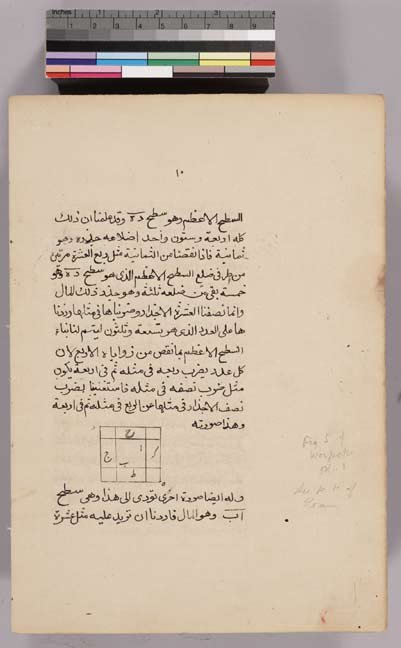- About MAA
- Membership
- MAA Publications
- Periodicals
- Blogs
- MAA Book Series
- MAA Press (an imprint of the AMS)
- MAA Notes
- MAA Reviews
- Mathematical Communication
- Information for Libraries
- Author Resources
- Advertise with MAA
- Meetings
- Competitions
- Programs
- Communities
- MAA Sections
- SIGMAA
- MAA Connect
- Students
- MAA Awards
- Awards Booklets
- Writing Awards
- Teaching Awards
- Service Awards
- Research Awards
- Lecture Awards
- Putnam Competition Individual and Team Winners
- D. E. Shaw Group AMC 8 Awards & Certificates
- Maryam Mirzakhani AMC 10 A Awards & Certificates
- Two Sigma AMC 10 B Awards & Certificates
- Jane Street AMC 12 A Awards & Certificates
- Akamai AMC 12 B Awards & Certificates
- High School Teachers
- News
You are here
Mathematical Treasures - Al-Khwarizmi's Algebra

This is a page from al-Khwārizmī's algebra text, Kitāb al-jabr wa'l-muqābala, written in about 825, the first extant algebra text, by Muḥammad ibn Mūsā al-Khwārizmī. This copy itself is undated, however. It corresponds to page 15 in the translation by Frederic Rosen: The Algebra of Muhammed ben Musa (London: Oriental Translation Fund, 1831), which is also available in a reprinting in the series on Islamic Mathematics and Astronomy, from the Institute for the History of Arabic-Islamic Science at the Johann Wolfgang Goethe University, Frankfurt am Main. On this page is al-Khwārizmī's proof of the rule for solving a quadratic equation of the form "squares plus roots equal numbers" (\(x^2 + bx = c\)). The central square in the diagram represents the square on the unknown. The four rectangles on the four sides of the square each have width \(\frac{b}{4}.\) Thus the area of the central square plus the four rectangles is \(c.\) The square is then completed by adding the four corner squares, each of side \(\frac{b}{4}.\) Thus, the area of the large square is, in modern notation, \[x^2 + bx + {\frac{b^2}{4}} = {\left(x + {\frac{b}{2}}\right)}^2,\] and this is in turn equal to \(c + {\frac{b^2}{4}}.\) The solution to the equation is then evident.
Frank J. Swetz and Victor J. Katz, "Mathematical Treasures - Al-Khwarizmi's Algebra," Convergence (January 2011)




